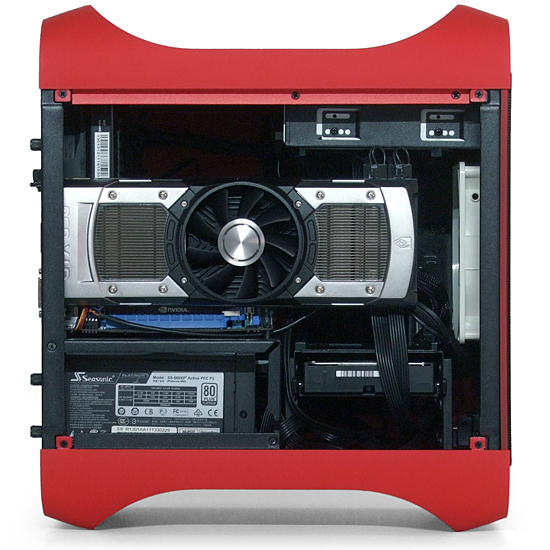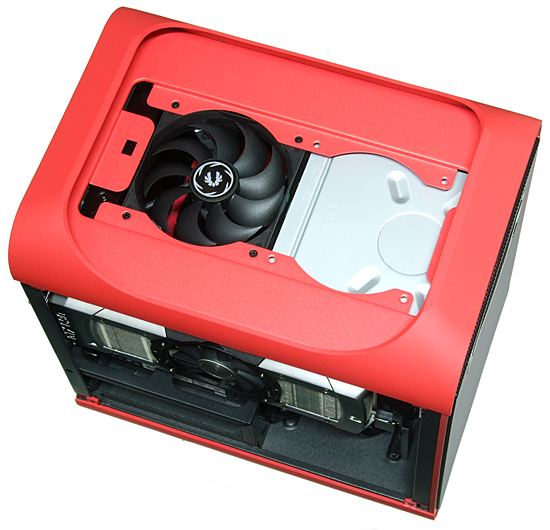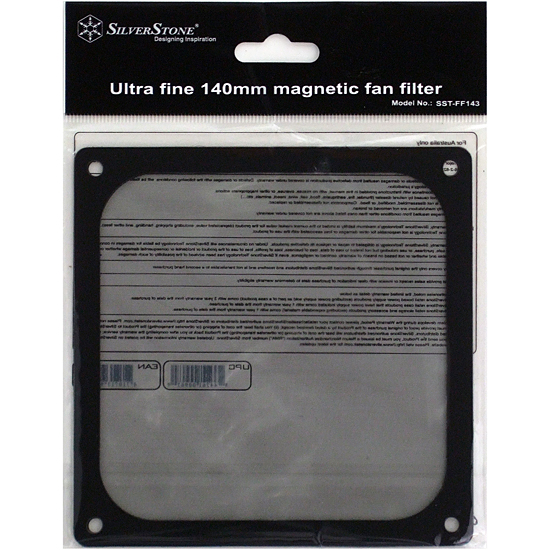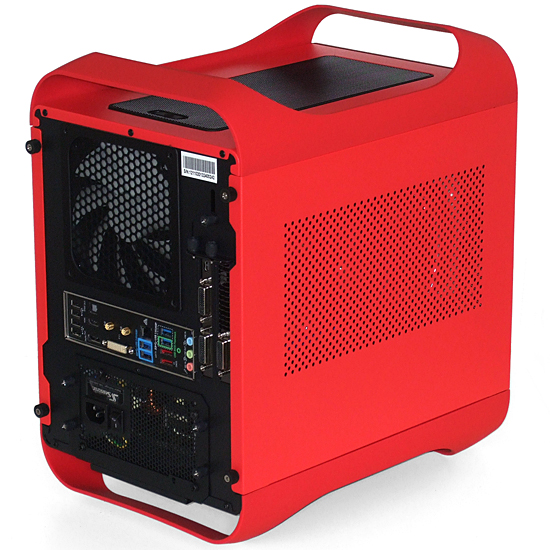System Builder Marathon, Q2 2013: $2500 Performance PC
Assembly Part 3: The Finishing Touches
At 6.25” deep, the modular power supply I chose is just a hair too large to easily fit inside the Prodigy’s mounting area. Holes on the sides of the bay would have made the insertion of a non-modular unit easier, since the cables of those parts exit at the side. But the added bulk of the extra cables also would have filled the hard drive cage, making a slightly shorter modular PSU the best solution. This one eventually fit with a little extra persuasion.
The video card vents heat out both the front and back, but its rear vents out of the case. A gap between the video card’s front vent and the case’s face panel would have allowed a rear exhaust fan to draw its hot air into the CPU zone. Knowing this, I planned this entire assembly with back-to-front cooling in mind. Cold air comes in through the radiator, blows past the voltage regulator only slightly warmer, and exits through the white fan in front. When gaming, I can feel the video card’s front vent exhausting directly through the front panel’s left edge.
The two factory-installed Prodigy case fans were removed, but not forgotten. There’s just enough empty space between the Kraken X40 closed-loop radiator and Asus BW-14D1XT optical drive to mount one of those fans, blowing down, to complement our back-to-front cooling path.
My biggest complaint about back-to-front cooling involves convection and dust control. The fans in this particular build are too close to the same height for convection to be a serious concern, and SilverStone’s 140 mm magnetic filter addresses the dust issue. Well done, if I may so so myself.
The filter simply sticks to the back, and the reversed fan draws it even more tightly into place. Were performance to have been below expectations, a graphics card intake gasket similar in concept to SilverStone’s solution could have been cut from a sheet of packing foam included in Newegg’s box.
Get Tom's Hardware's best news and in-depth reviews, straight to your inbox.
Current page: Assembly Part 3: The Finishing Touches
Prev Page Assembly Part 2: Now, For All Of The Parts That Fit... Next Page Overclocking-
sherlockwing Interesting $2500 MITX build, granted most people(including me) would have built a $2500 rig around 780 SLI in a ATX case.Reply -
burnley14 This just might be my favorite SBM ever, and this particular build my favorite machine of all time. Even if the relative value is slightly lower, many people including myself are willing to pay a small premium for a smaller footprint. Well done!Reply -
slomo4sho Seems I was pretty close in my initial guess:Reply
11002870 said:PCPartPicker part list / Price breakdown by merchant / Benchmarks
CPU: Intel Core i7-3770K 3.5GHz Quad-Core Processor ($319.99 @ Newegg)
CPU Cooler: Corsair H110 94.0 CFM Liquid CPU Cooler ($119.99 @ Newegg)
Motherboard: Asus P8Z77-I DELUXE/WD Mini ITX LGA1155 Motherboard ($207.55 @ Newegg)
Memory: Corsair Dominator Platinum 8GB (2 x 4GB) DDR3-2133 Memory ($149.99 @ Newegg)
Storage: Samsung 840 Series 500GB 2.5" Solid State Disk ($353.98 @ Newegg)
Storage: Western Digital Caviar Black 2TB 3.5" 7200RPM Internal Hard Drive ($159.99 @ Newegg)
Video Card: Asus GeForce GTX 690 4GB Video Card ($999.99 @ Newegg)
Case: BitFenix Prodigy (Black) Mini ITX Tower Case ($95.98 @ Newegg)
Power Supply: SeaSonic 660W 80 PLUS Platinum Certified ATX12V / EPS12V Power Supply ($148.54 @ Newegg)
Optical Drive: LG WH14NS40 Blu-Ray/DVD/CD Writer ($59.99 @ Newegg)
Total: $2597.99 -
agnickolov I wish the build had a 512GB SSD, but I understand the builder's value sentiment. The fast HDD is pure waste, however. A 2TB HDD can be found for under $100.Reply -
sarinaide Still struggling to get my mind on a high performance ITX system, to me its more a case of how much high end you can chuck into a psuedo M-ITX chassis which for all intents and purposes are not small form factor by any stretch of the imagination. Having owned a Prodigy they can hardly be said to be SFF when their total surface area is as much as a ATX chassis, it is like calling a HAF XB M-ITX.Reply
The main point of the article is that diminishing returns are high at that price point, only a overclocked system (again not a fan of in the confineds of a ITX system) give it value. -
csf60 I would take a 770 and water-cool that rig any day, but I suppose that's personal preference.Reply -
sarinaide It is safe to say that the purpose of the machine is gaming, for that is there any particular reason to go with the i7 other than to say you maxed the platforms highest capable chip but in terms of true benefits there is little over an i5 yet over a $100 been dropped on it. The next question is why not a GTX Titan, most of a 690 's performance but on less power and heat which is quite punishing in a Prodigy's confinds.Reply -
Crashman Reply
At the initialization's initiation, SFF meant "Shuttle Form Factor". The term has since been abused for everything from Micro ATX gaming cubes to book-sized PCs. Book-sized system builders would argue that Shuttle's fairly big traditional boxes aren't true SFF because they're too big, even though the term originally referred to these! If you remove the handles, this case is roughly the size of Shuttle's old 2-slot boxes (it's around 2 inches taller and 2 inches shorter in length)11028708 said:Still struggling to get my mind on a high performance ITX system, to me its more a case of how much high end you can chuck into a psuedo M-ITX chassis which for all intents and purposes are not small form factor by any stretch of the imagination. Having owned a Prodigy they can hardly be said to be SFF when their total surface area is as much as a ATX chassis, it is like calling a HAF XB M-ITX.
The main point of the article is that diminishing returns are high at that price point, only a overclocked system (again not a fan of in the confineds of a ITX system) give it value.
Gaming only? Then when the Core i7?11028926 said:It is safe to say that the purpose of the machine is gaming
Read pages 16 and 1711028926 said:is there any particular reason to go with the i7
Did you see the overclocking section? Three mediocre i5's in a row and i7 leads to O/C victory, in addition to the gains on pages 16 and 17.11028926 said:other than to say you maxed the platforms highest capable chip but in terms of true benefits there is little over an i5
Did you see a heat issue? I did not. Why would someone want to spend more money for less gaming performance? Or are you now saying that this is not a gaming PC?11028926 said:The next question is why not a GTX Titan, most of a 690 's performance but on less power and heat which is quite punishing in a Prodigy's confinds.





